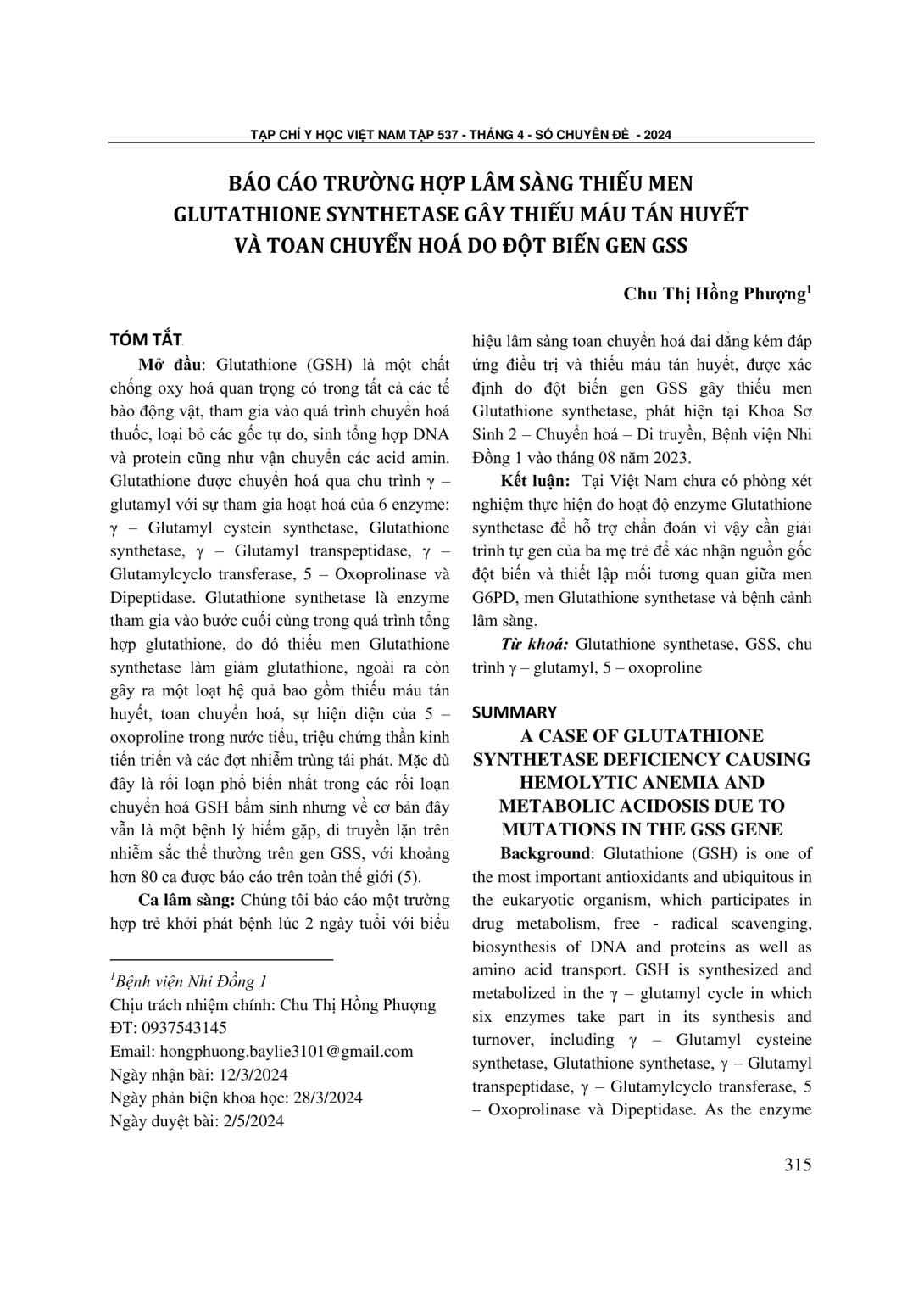
Glutathione (GSH) là một chất chống oxy hoá quan trọng có trong tất cả các tế bào động vật, tham gia vào quá trình chuyển hoá thuốc, loại bỏ các gốc tự do, sinh tổng hợp DNA và protein cũng như vận chuyển các acid amin. Glutathione được chuyển hoá qua chu trình γ – glutamyl với sự tham gia hoạt hoá của 6 enzyme: γ – Glutamyl cystein synthetase, Glutathione synthetase, γ – Glutamyl transpeptidase, γ – Glutamylcyclo transferase, 5 – Oxoprolinase và Dipeptidase. Glutathione synthetase là enzyme tham gia vào bước cuối cùng trong quá trình tổng hợp glutathione, do đó thiếu men Glutathione synthetase làm giảm glutathione, ngoài ra còn gây ra một loạt hệ quả bao gồm thiếu máu tán huyết, toan chuyển hoá, sự hiện diện của 5 – oxoproline trong nước tiểu, triệu chứng thần kinh tiến triển và các đợt nhiễm trùng tái phát. Mặc dù đây là rối loạn phổ biến nhất trong các rối loạn chuyển hoá GSH bẩm sinh nhưng về cơ bản đây vẫn là một bệnh lý hiếm gặp, di truyền lặn trên nhiễm sắc thể thường trên gen GSS, với khoảng hơn 80 ca được báo cáo trên toàn thế giới (5). Ca lâm sàng: Chúng tôi báo cáo một trường hợp trẻ khởi phát bệnh lúc 2 ngày tuổi với biểu hiệu lâm sàng toan chuyển hoá dai dẳng kém đáp ứng điều trị và thiếu máu tán huyết, được xác định do đột biến gen GSS gây thiếu men Glutathione synthetase, phát hiện tại Khoa Sơ Sinh 2 – Chuyển hoá – Di truyền, Bệnh viện Nhi Đồng 1 vào tháng 08 năm 2023. Kết luận: Tại Việt Nam chưa có phòng xét nghiệm thực hiện đo hoạt độ enzyme Glutathione synthetase để hỗ trợ chẩn đoán vì vậy cần giải trình tự gen của ba mẹ trẻ để xác nhận nguồn gốc đột biến và thiết lập mối tương quan giữa men G6PD, men Glutathione synthetase và bệnh cảnh lâm sàng.
Glutathione (GSH) is one of the most important antioxidants and ubiquitous in the eukaryotic organism, which participates in drug metabolism, free - radical scavenging, biosynthesis of DNA and proteins as well as amino acid transport. GSH is synthesized and metabolized in the γ – glutamyl cycle in which six enzymes take part in its synthesis and turnover, including γ – Glutamyl cysteine synthetase, Glutathione synthetase, γ – Glutamyl transpeptidase, γ – Glutamylcyclo transferase, 5 – Oxoprolinase và Dipeptidase. As the enzyme catalyses the last step of GSH synthesis, Glutathione synthetase deficiency leads to low cellular GSH. As a result, it leads to a series of consequences comprising hemolytic anemia, metabolic acidosis, 5 – oxoprolinuria, progressive CNS symptoms, and recurrent bacterial infections. Although deficiency of glutathione synthetase is the most common inborn error of GSH metabolism, it is still a rare autosomal recessive disorder in the GSS gene with more than 80 patients having been reported worldwide (5). Case report: We report a case of a newborn whose onset of disease at 2 days old with clinical manifestations of persistent metabolic acidosis and hemolytic anemia, which was confirmed its genetic cause of mutations in the GSS gene leading to Glutathione synthetase deficiency. This case was detected at the Department of Neonatology 2 - Metabolism & Genetics, Children’s Hospital 1 in August 2023. Conclusion: In Vietnam, there is no laboratory that measures Glutathione synthetase enzyme activity to support diagnosis, so it is necessary to sequence the genes of the child's parents to confirm the origin of the mutation and establish a correlation between G6PD, Glutathione synthetase and clinical feature.
- Đăng nhập để gửi ý kiến
